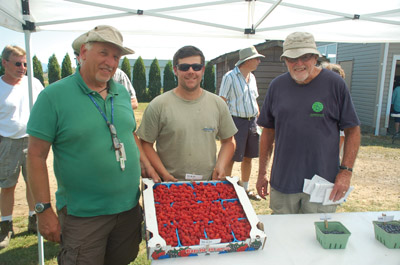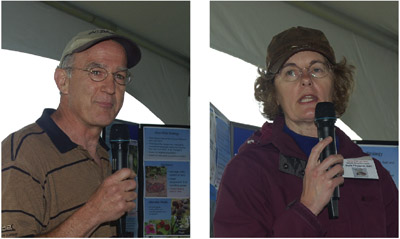
Features
Chemicals
Insects
B.C. berry growers get pest update during research gathering
September 16, 2010 By David Schmidt
Berry growers in British Columbia had an opportunity to hear the latest
on spotted wing drosophila (SWD), the newest insect to invade the
province, during a recent berry research day held at Agriculture &
Agri-Food Canada’s Pacific Agriculture Research Centre (PARC)
substation, located near Abbotsford, B.C.
Berry growers in British Columbia had an opportunity to hear the latest on spotted wing drosophila (SWD), the newest insect to invade the province, during a recent berry research day held at Agriculture & Agri-Food Canada’s Pacific Agriculture Research Centre (PARC) substation, located near Abbotsford, B.C.
 |
|
| B.C. Raspberry Growers Association president David Mutz (centre) brought a flat of raspberries from his trial rows of 92-9-15 berries. With him are current PARC berry breeder Chaim Kempler (left) and retired former PARC berry breeder Hugh Daubeny (right), who made the original cross in 1992. Photos by David Schmidt Advertisement
|
Discovered in Fraser Valley berry fields towards the end of the 2009 harvest, the SWD is an Asian fruit fly that can cause devastating losses in berries and soft fruits. In 2008 and 2009, the fruit fly caused 20 to 50 per cent yield losses in California berry fields and soft fruit orchards.
“SWD is like a bad horror movie,” said Mark Sweeney, a B.C. Ministry of Agriculture and Lands (BCMAL) berry specialist. “It’s out there to ruin our businesses.”
The tiny SWD, which measures only 3 millimetres, is the only fruit fly to infest ripe fruit on the vine.
“The female lays its eggs in the fruit and the larvae can pupate in it,” explained BCMAL entomologist Tracy Hueppelsheuser.
Since it has only a one- to three-week life cycle, the pest could go through up to five generations in a single season. Although the hole where the female has laid its eggs is visible in blueberries and cherries, it is not in raspberries and strawberries, making detection that much more difficult.
The best way to find the insect pest is through sweep netting, trapping or fruit collection. Fruit collection is the most accurate, but slowest, way of finding the pest as it takes up to two weeks to raise flies for identification. Trapping is easiest using either the commercially available Contech fruit fly trap or an improvised “Agassiz” trap created by PARC researcher Sheila Fitzpatrick. She is testing both traps using two types of bait (yeast and apple cider vinegar) to determine which combination is most effective.
 |
|
| (Left) B.C. Ministry of Agriculture and Lands (BCMAL) berry specialist Mark Sweeney discusses the latest issues related to control of spotted wing drosophila. (Right) Agriculture & Agri-Food Canada researcher Sheila Fitzpatrick describes her work testing fruit fly traps to determine which bait combination is most effective.
|
Fitzpatrick, the Canadian Food Inspection Agency (CFIA) and local IPM consultant ES Cropconsult have set up several hundred traps in berry fields and cherry orchards throughout the Fraser Valley, Okanagan Valley and southern Vancouver Island. Intensive trapping is also occurring in the three fields where the pest was originally found in 2009.
The initial news is as positive as it could be.
“There is no need for undue concern,” Fitzpatrick told growers during the research day. “I don’t think we’ll have the same problem we had in August and September last year.”
However, Sweeney warned growers not to become complacent. Since “the science isn’t there” to determine if and when to spray for the SWD, he told growers to “go on your gut instinct. We’re probably all right in the short term but we don’t know what will happen in the heat.”
The Pest Management Regulatory Agency (PMRA) has given emergency registrations to three chemicals (Delegate WG, Ripcord 400 EC, Malathion 85E) and one organic pesticide (Entrust 80W) to combat SWD. They are registered for use in B.C. until Oct. 31, 2010.
Since all four products are toxic to bees, and since unripened fruit is not susceptible, growers should only spray after fruit begins ripening and then only at night when bees aren’t foraging, suggested Sweeney.
He said there is still insufficient information about pest thresholds or spray intervals. “California is talking about 14 to 21 days in tunnels but we’re advising 10 to 14 days in open fields. We also encourage a post harvest dump spray because of the leftover fruit.”
Sweeney also urged growers to remove or bury cull fruit to eliminate potential SWD breeding and feeding sites.
The July berry research meeting also provided an opportunity for growers to hear about the latest berry breeding research being performed at PARC.
Totem, a strawberry variety released in 1971 by the AAFC strawberry-breeding program at PARC, remains the most popular strawberry variety in the Pacific Northwest (BC-WA-OR) but has become only a minor variety in B.C. Last year, Totem represented more than 28 per cent of all strawberry plantings in the Pacific Northwest but less than seven per cent of new plantings in B.C. Instead, B.C. growers appear more interested in planting Albion (19.7 per cent), Puget Reliance (16 per cent) and Rainier (13.6 per cent). While these three varieties represent about half of B.C. plantings, they total less than 22 per cent of all plantings in the PNW.
The situation in raspberries is different, with B.C. plantings similar to those in the rest of the Pacific Northwest. Meeker remains the dominant variety, with more than 50 per cent of new plantings in B.C. and the rest of the PNW. However, that could change, as PARC released the Ukee and Rudyberry varieties last year and is close to releasing at least two other new varieties.
“We expect the Rudyberry to be taken up by growers (when it is available for commercial plantings next year) but Ukee doesn’t seem to have generated much grower interest, even though it is root rot resistant,” explained PARC berry breeder Chaim Kempler.
Kempler also promoted two as-yet-unnamed varieties: 92-9-15 and 92-22R-55. He believes his favourite, 22R-55, which is very resistant to root rot and machine harvests well, would make a good replacement for Willamette, long a staple of the B.C. raspberry sector.
However B.C. Raspberry Growers Association president David Mutz of Berry Haven Farms in Abbotsford is more supportive of 9-15, which he has been growing on a trial basis. It offers better root resistance than Malahat, a popular variety in B.C., and one of the new berry’s parents.
“We have tried it twice now and it’s worked for us both times,” Mutz said, adding “I don’t know why the program has been so slow to release it.”
Representatives of Sakuma Brothers, the Washington State nursery that propagates virtually all PNW berry varieties in the region, assured growers the company would have some 9-15 and other promising new varieties available for early release next spring. However, growers will have to wait until 2012 to get their hands on Nisga’a, the early strawberry variety PARC plans to release next year.
Nisga’a offers good root rot resistance and may be suitable for the fresh market, which is where about 90 per cent of B.C. strawberries are sold.
Print this page